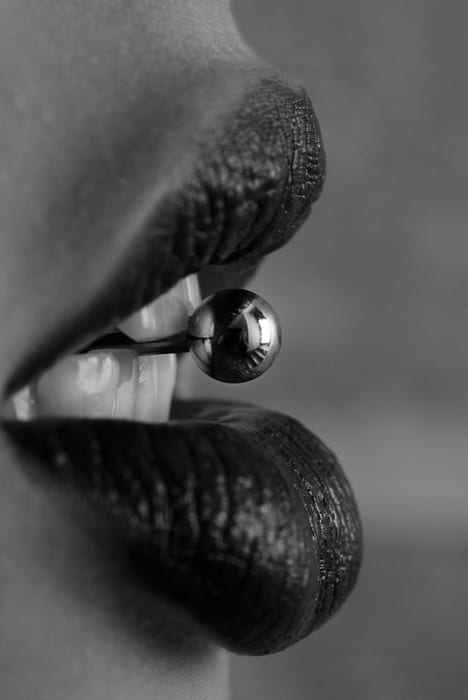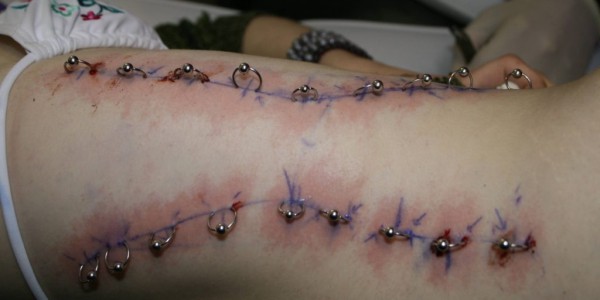Piercing Information
Palm Springs Piercing Company provides the highest quality jewelry available in the industry. Our stainless body jewelry is internally threaded and countersunk for safety and ease of wear. Our jewelry is ALL either 316LVM or 316L implant grade stainless steel, titanium, or gold. We sell certified US, Canadian, or European made jewelry – not jewelry made from the many metals and varieties of stainless steel not appropriate for wear in the human body. Our 14 and 18 karat gold is custom made and uses hypoallergenic palladium as the curing agent, not nickel. Because we sell premium quality jewelry we can offer replacements parts and repair should our clients require.
Palm Springs Piercing
We proudly carry jewelry by Industrial Strength, Anatometal, LeRoi, Tawapa, Glasswear Studios and Oracle Body Jewelry!
PSPC professionals will assist with the selection of the most appropriate jewelry for your new piercings and will provide service and post-sales support for all your body jewelry purchases.
Our selection includes all major and specialty styles of body jewelry for every conceivable piercing, including:
Barbells, Curved Barbells, Circular Barbells, Captive Bead Rings, Studs, Plugs, Eyelets, and many others!
Body Piercings
Body piercings are broadly categorized
– Above the neck and oral piercings
– Nipple and naval piercings
– Male genital piercings
– Female genital piercings
– Multiple and unique piercings
– Transdermal implants (Singlepoints), Beading and Subdermal implants
Healing
Healing Times
Healing times listed below are averages for most individuals in good health. Actual healing times can vary considerably based on the individual and the quality of after-care of the piercing.
Above the Neck
Monroe/Crawford/Medusa: 2-4 months
Erl/Earl: 3–6 months
Cheek/Anti-Eyebrow: 3–6 months
Ear cartilage: Up to a Year
Earlobes: 2-3 months
Eyebrow: 1-3 months
Tragus: 6–12 months
Lip/Labret: 2-3 months
Nostril: 3–6 months
Septum: 3–4 months
Tongue: 2-3 months
Torso
Nipples: 4-6 months
Navel: 4–8 months
Hand Web: 12 months – never
Most Surface: 6–8 months
Female Genital Piercings
Clitoral Hood: 2–3 months
Clitoris: 4-6 weeks
Fourchette: 2–3 months
Labia Minora: 2–3 months
Labia Majora: 2–6 months
Triangle: 2–3 months
Male Genital Piercings
Ampallang: 6-9 months
Apadravya: 6-9 months
Dydoe: 3–4 months
Frenum: 2-3 months
Guiche: 3-5 months
Prince Albert: 4–6 weeks
Reverse Prince Albert: 4–6 months
Scrotum/Hafada: 2-3 months
Foreskin: 2–3 months
Lorum: 2-3 months
Aftercare Suggestions
Keep it Clean
Congratulations on your new piercing! You are probably very excited about your experience, and you should be; getting pierced is a very big deal. Your piercing needs love and attention. It is up to you to provide that care wholeheartedly. A little bit of effort on your part will go a long way in the healing process. Cleaning your piercing, although a simple task, is extremely important to ensure the health and beauty of your new piercing.
These aftercare suggestions are intended to help you through the healing process. Following our simple instructions*, which are based on information presented in studies on wound care and on years of piercing experience, can help to keep the healing process going smoothly.
When it comes to the question of what to use to heal a piercing, we have found that non-iodized sea salt is the most successful treatment material. By mixing one-quarter (¼) teaspoon of sea salt to 8 ounces of clean water, a saline solution is created. This mixture of sea salt and water works with your body’s chemistry, helping your body do its job in healing the wound. Do not use table salt, Epsom or bath salts. Sea salt is readily available—very inexpensively—from our store, most health food stores and some grocery stores.
The saline solution works best when applied to the piercing as follows:
ORAL PIERCINGS:
Oral piercings include those done in the mouth (tongue, etc.). On piercings such as labrets, which include the mouth area, the portion of the piercing in the mouth should be treated as an oral piercing. Rinsing of your oral piercing is done quite often and, since it works with your body, your mouth won’t mind if you rinse it many times throughout the day. Mix your saline solution ahead of time and keep some with you. One suggestion is to buy a bottle of drinking water and for every 8 oz. of water mix in ¼ tsp. of sea salt. Most people rinse after eating, smoking, or drinking anything other than bottled water, but feel free to rinse whenever you feel it is necessary. Oral piercings most benefit from the rinsing regimen during the first three to six weeks.
TIPS FOR ORAL PIERCINGS:
Think COLD! Ice and cold drinks can help reduce swelling. An over-the-counter anti-inflammatory, such as ibuprofen, will also be helpful. Check the ends of threaded jewelry and make sure they are tight. They work like a screw, i.e. right is tight, left is loose. Don’t irritate the piercing by playing with it until it is fully healed. AVOID wet kissing or oral sex, and cut down or stop smoking. Smokers will experience more discomfort, excessive swelling and a longer healing time than non-smokers.
NON-ORAL PIERCINGS:
Non-oral piercings include all others. For piercings like labrets, the exterior is considered non-oral. Most piercings heal fastest when the get a 10-minute saline soak, twice per day. The best way to do this is to mix ¼ tsp. with 8 oz. of water in a cup (bottled or distilled is best). Either lower the piercing into the cup, or flip the cup against your skin at the piercing site (this works best on flat surfaces such as nipples, navels, etc.). If neither is practical, which is rare, rinsing or application to the piercing with a clean cotton swab or gauze should suffice, but submerging the piercing works best. Cleaning around the piercing while in the shower with a gentle anti-bacterial soap made for sensitive skin can be beneficial. Do not soap more than once a day and make sure you rinse all soap off the pierced area.
NON-ORAL PIERCING TIPS:
After soaking the piercing for a few minutes, use a clean cotton swab to remove the crustiness (this is dried lymph and is normal). Do not wear any tight or restrictive clothing against your piercing, especially with navel piercings. Wear clean clothes and bathe daily. If you work out, be sure to clean your piercing as soon as possible post-exercise. Clean sheets and pillowcases are important. Avoid contact between hair or make-up and your piercing.
NORMAL HEALING:
Clear to slightly yellow crusties, occasional mild bleeding during the first few days, redness, tenderness, itchiness and moderate swelling are all normal after a piercing.
TIPS FOR ALL PIERCINGS:
Wash your hands before touching the piercing and only touch when cleaning. NO contact between your piercing and other people’s body fluids should occur during the healing process. Poor diet, stress and lack of sleep all have a negative effect on healing time. Remember to check the ends for tightness on threaded jewelry. AVOID petroleum based ointments (Neosporin, Bacitracin), peroxide, alcohol, Betadine and Hibiclens.
*The suggestions listed here are simply that: suggestions. They are in no way to be construed as medical advice; we are not doctors. All suggestions are based on our experience as piercing professionals.



